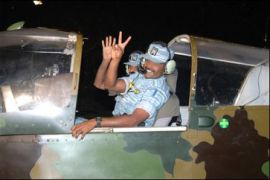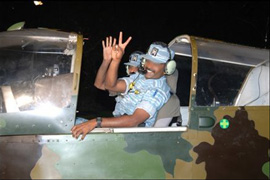The roar of the Tigers
Separatist air strike in Sri Lanka causes small damage but inflicts big psychological blow.

 |
| The Tigers struck the base near Sri Lanka’s only international airport [AFP] |
The Tamil Tiger separatists’ night-time air raid on Sri Lanka’s largest air force base last week has inflicted a heavy psychological blow on the country’s defence establishment.
The attack failed to cause significant damage but was a sign that, as the conflict escalates and hopes for a peaceful settlement fade, the separatists may be able to surprise much better equipped government forces.
Vice-Air Marshall Harry Goonetileke, a former air force chief, told Al Jazeera: “Our alertness has to increase 100 per cent.”
“The LTTE have emerged as the first terrorist organisation in the world to fly aircraft fitted with improvised explosives, release their bombs and return safely to base.”
P K Balanchandran, an Indian journalist who has been covering the conflict in Sri Lanka for more than 10 years said: “In a classic military situation of two countries at war, there is usually advance notice of air action.
“In a situation of terrorism, however, the attack can take place anywhere at any time. This poses an enormous problem for the defence establishment, psychological or otherwise.”
Shock attack
Three airmen died and 16 were injured when two LTTE light aircraft bombed the Katunayake air force base near Colombo shortly after midnight on March 25.
The camp adjoins the country’s only international airport. The bombs landed in the engineering division, not far from the separatists’ target: hangars housing Kfir and MiG27 aircraft which have for months been pounding locations in LTTE-controlled territory.
State intelligence knew for some years that the LTTE possessed light aircraft, smuggled into the country in parts and reassembled. Unmanned Aerial Vehicles belonging to the air force had photographed at least two air strips in Tiger territory which were subsequently bombed by the air force.
 |
| The Tamil Tigers show off their new air force |
However, no one had expected the LTTE to fly their planes for 90 minutes to drop gravity bombs on an air force base 200km away and return successfully.
The shock attack has had the state scrambling to upgrade its air defence system.
Brigadier Prasad Samarasinghe, a military spokesman, said: “Our contingency plans had not worked properly but we are introducing suitable air defence systems and measures to counter a future threat.”
Neighbouring India is also jittery. Agency reports state that eight radar stations have been set up as a precautionary measure in the district of Ramanathapuram and a 50-member team deployed at the sites.
“There is the fear, too, that another terrorist group in India or the region could replicate this attack,” Balachandran said. “This could spread like suicide bombing, something else the Tigers are credited with pioneering.”
The government has held meetings with foreign diplomats to warn them about the international dimensions of the Tiger air raid.
Gotabaya Rajapaksa, the defence minister, said: “All sovereign nations should take this incident, not as an isolated one, but as something to expect from all major terrorist groups if steps are not taken to eliminate [them] right now.”
Dial-an-aircraft
Apart from working rapidly to acquire modern radars, a national hotline has been set up.
In a move that has had some defence analysts laughing, the public is being urged to telephone 116 if they see suspicious aircraft.
“We get calls every hour,” said an air force officer on telephone duty. “I’m too busy to tell you how many calls we get, but we do get a lot.”
Samarasinghe said some of the calls were prompted by sounds of the air force’s own craft, as a nervous public keeps watch. “We are thankful for this level of vigilance,” he added.
Meanwhile, analysts observe that the air operation has given the Tigers a critical morale boost.
Paikiasothy Saravanamuttu, executive director of the Centre for Policy Alternatives, an independent think-tank, said: “For some time now, the news from the battlefield has not been jolly.
“The LTTE has been on the defensive. Tactical or strategic retreats notwithstanding, the east has been a debacle whichever way you cut it.
“Therefore, there was a need to remind all and sundry that the LTTE had not lost its ability to at least surprise and by doing so upset the status quo as far as the balance of power is concerned.”
Just hours after the attack, the LTTE released photos of the “Air Tigers” on TamilNet, a website sympathetic to them.
The accompanying report stated that the separatists had used locally designed payload carrying mechanisms and automatic ammunition discharge circuitry while also demonstrating a capability for night-time missions.
Goonetileke accepted that the Tigers had a proven capacity to be innovative but dismissed their position that they had an “air force”.
“One swallow never made a summer,” he said. “The possession of two light aircraft doesn’t make the LTTE a lethal air force. However, they can be annoying. Very annoying.”
Saravanamuttu, too, downplayed the impact of the air strike. “In terms of actual destruction the damage was minimal. The ability of the air force to pound the Wanni, and at will, is still in tact,” he said, adding that the air strike was just “chutzpah”.
But he, like other political analysts, said an intensification of fighting seemed inevitable, warning that the outlook for civilians in conflict areas was grim.
“What is to follow? In all likelihood more bombing of LTTE controlled territory by the air force, more death, destruction and misery for civilians,” Saravanamuttu said.
“Were this to be a flash in the pan by the LTTE and not a harbinger of things to come, the government will be further emboldened in its belief that the LTTE has lost the plot and is irreversibly in decline.”